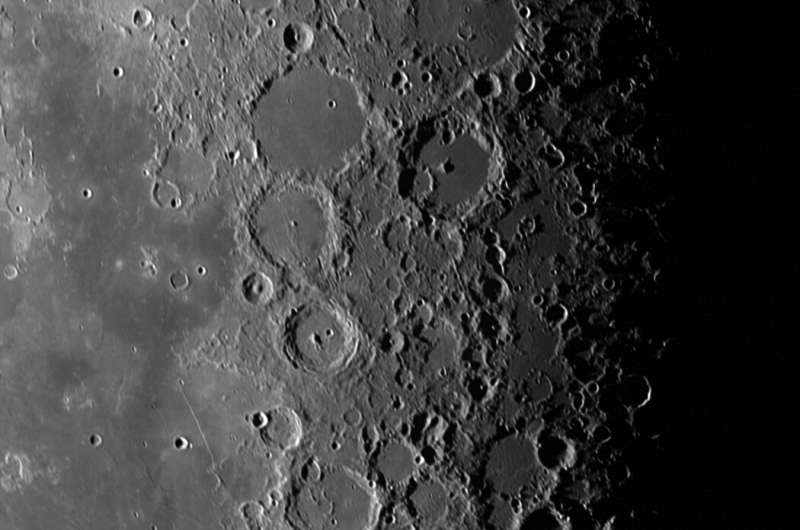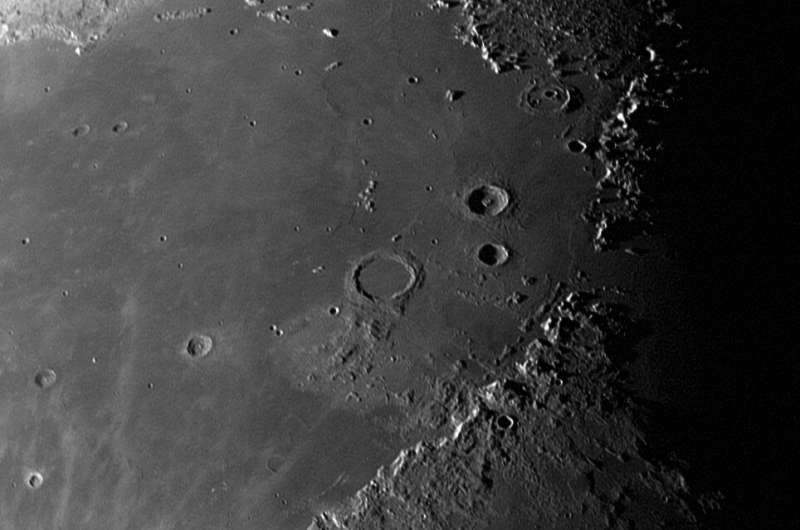Images: NASA's Lucy spacecraft provides new views of the moon

NASA's Lucy spacecraft captured this image of the moon's surface on Oct 16, 2022, about 6.5 hours after it flew by the Earth for its first of three gravity assists. The image was taken while Lucy was between the Earth and the moon, approximately 160,000 miles (260,000 km) from the moon, so it shows shows a perspective familiar to Earth-based observers. The image is of a 800 mile (1200 km) wide patch near the center of the last quarter moon. Many familiar craters are visible, including the relatively fresh crater Arzachel just left of center. The prominent fault scarp called the Straight Wall is visible cutting across the lava plains to the lower left of center.
The image, which is made by combining ten separate 2 millisecond exposures of the same scene to maximize image quality, has been sharpened. Each pixel represents approximately 0.8 miles (1.3 km).
This image was taken with L'LORRI (Lucy LOng Range Reconnaissance Imager), Lucy's high resolution greyscale imager. L'LORRI was provided and operated by Johns Hopkins Applied Physics Laboratory.
Terminator mosaic

NASA's Lucy spacecraft captured this mosaic of the moon's surface on Oct 16, 2022, between 7.5 and 8 hours after it flew by the Earth for its first of three gravity assists. At its closest approach, the flyby took the spacecraft within 224 miles (360 km) of the Earth, passing below the altitude of the international space station. Lucy was an average of approximately 140,000 miles (230,000 km) from the moon when these images were taken.
The mosaic was taken while Lucy was between the Earth and the moon, so it shows a perspective familiar to Earth-based observers, centered near the terminator of the last quarter moon. The view includes the rugged, heavily cratered, Southern Highlands near the bottom of the mosaic, and the ancient, lava-filled impact basin Mare Imbrium near the top. The bright, fresh crater Copernicus is conspicuous near the left edge of the mosaic.
This mosaic, which is made from 5 separate 1 millisecond exposures, has been sharpened. Note that the image covering the uppermost portion of the edge of the moon was taken at an earlier time, resulting in a small mismatch in the images there. Each pixel represents approximately 0.7 miles (1.2 km).
Single frame of Mare Imbrium

NASA's Lucy spacecraft captured this image of the moon's surface on Oct 16, 2022, about 8 hours after it flew by the Earth for its first of three gravity assists. The image was taken while Lucy was between the Earth and the moon, so it shows a perspective familiar to Earth-based observers. The image shows a roughly 600 mile (1000 km) wide swath of lunar terrain, dominated by the ancient, lava-filled impact basin Mare Imbrium. The Apennine Mountains, part of the Imbrium basin rim, which were the landing site for the Apollo 15 mission in 1971, dominate the lower-right portion of the image. Lucy was approximately 140,000 miles (230,000 km) from the moon when the image was taken.
The image, which is a single 1 millisecond exposure, has been sharpened. Each pixel represents approximately 0.7 miles (1.1 km).
Provided by NASA





















